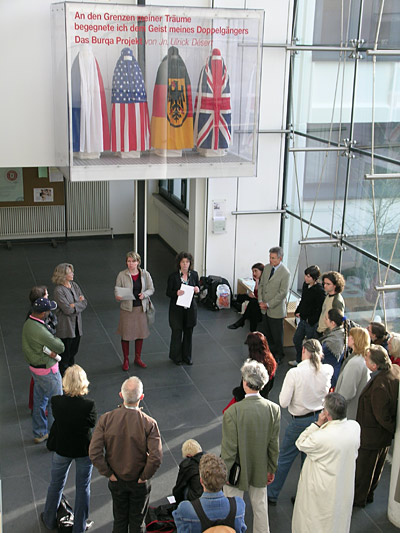LIFTARCHIV
Munich, 2011-2014
Kreisverwaltungsreferat (KVR)
Ruppertstr. 19, Foyer Lindwurmstraße, München
Glass elevator cabin 2,9 x 1,5 x 2,4 m
Elevator construction extendable to the height of 9 m, changing installations.
www.liftarchiv.de
Publication, Liftarchive, Szuper Gallery, Revolver, 2014
︎download PDF
Paintings, Liftarchive
Munich, 2011-2014
Kreisverwaltungsreferat (KVR)
Ruppertstr. 19, Foyer Lindwurmstraße, München
Glass elevator cabin 2,9 x 1,5 x 2,4 m
Elevator construction extendable to the height of 9 m, changing installations.
www.liftarchiv.de
Publication, Liftarchive, Szuper Gallery, Revolver, 2014
︎download PDF
Paintings, Liftarchive

The Liftarchiv is a multifaceted art installation and archive, housed in a glass elevator structure at the immigration office within Munich’s district authority building (Kreisverwaltungsreferat). Completed in 2001 as part of the city’s public art program (QUIVID), the project serves as both a physical archive and an ongoing artistic intervention in public space.
This glass cube, which moves vertically within the entrance hall, explores themes of transparency, surveillance, and bureaucratic control. Its design allows visibility from both inside and outside the building, symbolizing how state institutions monitor and regulate public life. When raised, the elevator becomes a sealed, inaccessible space—a metaphor for the unattainable nature of certain forms of knowledge or authority. This duality, where the Liftarchiv is a participatory space at ground level but a distant, symbolic object when elevated, creates a tension between public interaction and the inaccessibility of institutional processes.
Throughout its active phase, the Liftarchiv hosted a range of art events, exhibitions, and installations, engaging visitors in discussions about public space, governance, and migration. These activities were documented, and the archive now serves as a permanent installation, housing videos, photographs, and documents that preserve the creative and discursive moments generated by the project.
The Liftarchiv is both a mobile, performative object and a public sculpture. Szuper Gallery mounted the glass cube onto a lift in the KVR's foyer, where it functions as a living archive, continually added to through a series of events and collaborations. The transparent design of the foyer allows the archive to be visible from both the foyer and the street. However, when the archive is elevated, viewers are denied access, transforming it into a symbolic, inaccessible space—a three-dimensional portrait of a room. After the project's active phase, the Liftarchiv and its contents—photographs, objects, and documents—remain as a permanent installation, preserving the ongoing dialogue the project sought to initiate.
The KVR, as the city’s district authority, is responsible for a range of civic matters, including security, immigration, citizenship, and traffic regulation. The renovation of the 1970s building by architects Grill + Köppel and R. Dörnfeld aimed to create a more open and transparent public institution, aligning with the themes explored in the Liftarchiv.





